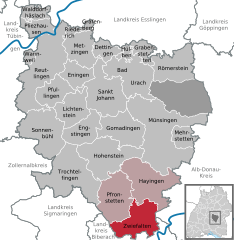Zwiefalten
| Zwiefalten | ||
|---|---|---|
 | ||
| ||
 Zwiefalten | ||
Location of Zwiefalten within Reutlingen district 
 | ||
| Coordinates: 48°13′57″N 09°27′51″E / 48.23250°N 9.46417°ECoordinates: 48°13′57″N 09°27′51″E / 48.23250°N 9.46417°E | ||
| Country | Germany | |
| State | Baden-Württemberg | |
| Admin. region | Tübingen | |
| District | Reutlingen | |
| Government | ||
| • Mayor | Matthias Henne (CDU) | |
| Area | ||
| • Total | 45.43 km2 (17.54 sq mi) | |
| Population (2012-12-31)[1] | ||
| • Total | 2,187 | |
| • Density | 48/km2 (120/sq mi) | |
| Time zone | CET/CEST (UTC+1/+2) | |
| Postal codes | 88529 | |
| Dialling codes | 07373 | |
| Vehicle registration | RT | |
| Website | www.zwiefalten.de | |
Zwiefalten is a municipality in the district of Reutlingen, located halfway between Stuttgart and Lake Constance. The former Zwiefalten Abbey dominates the town. The former monastery is considered one of the finest examples of late Baroque art.
History

Founded at the confluence of two rivers, Zwivaltum was mentioned for the first time in a document by King Ludwig IV dated 15 June 904, but the town's claim to fame is its former Benedictine monastery, the Zwiefalten Abbey, which was founded in 1089 by monks from Hirsau. Counts Luitold von Achalm and Kuno von Wülflingen gave extensive donations the monastery. There was also at one time a convent on the spot, but by the 14th century it was no longer there. Until the 15th century, the monastery was influential, but in 1525 the German Peasants' War resulted in the monastery being plundered.
In 1750 the abbey was granted the status of Reichsabtei, which meant that it had the status of an independent power subject only to the Imperial Crown and was free of the rule of Württemberg. By 1802, however, the monastery was dissolved as part of the German mediatization. Today it is part of the psychiatric hospital.
Politics
Mayors
The mayor is selected for one term of office of 8 years. The term of office of the present mayor, Hubertus Jörg Riedlinger, ends on 1 July 2014.
Coat of arms
On a blue background are interlocking rings, which symbolize the confluence of the Zwiefalter Aach and the Kessel Aach. The golden stars originate from the coat of arms of the former Counts of Achalm.
References
- ↑ "Gemeinden in Deutschland mit Bevölkerung am 31.12.2012 (Einwohnerzahlen auf Grundlage des Zensus 2011)". Statistisches Bundesamt (in German). 12 November 2013.
External links
| Wikimedia Commons has media related to The Abbey of Zwiefalten. |
| ||||||||
